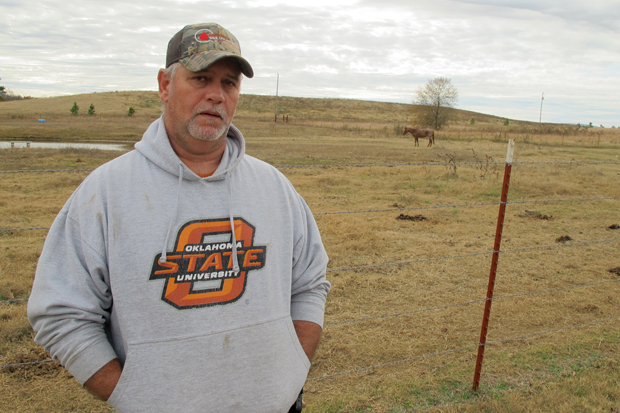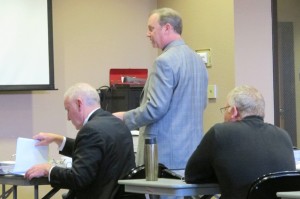
Leflore County resident Alan Brady says the large berm in the background blocks the view of the mountains he had before mining started.
Logan Layden / StateImpact Oklahoma


Leflore County resident Alan Brady says the large berm in the background blocks the view of the mountains he had before mining started.
Logan Layden / StateImpact Oklahoma

Logan Layden / StateImpact Oklahoma
Leflore County resident Alan Brady says the large berm in the background blocks the view of the mountains he had before mining started.
Oklahoma and the federal government aren’t getting along.
From health insurance exchanges to power plant emissions, the Obama Administration just can’t seem to get Oklahoma to play ball.
And there’s a lesser-known fight that’s starting to get more attention — over coal mining. More specifically, how land is treated after it’s mined.
There’s a hearing underway in Poteau this week, where attorneys for Farrell-Cooper Mining Company are appealing federal violations at three of its former mines.
The Tulsa branch of the federal Office of Surface Mining issued the violations to Farrell-Cooper, saying the mines are out of compliance with the Surface Mining Control and Reclamation Act. Specifically, the part of the law that requires land to be restored to its ‘approximate original contour.’
“If you’ve got gently rolling hills the law says you should return the land to its closest form and function with those gently rolling hills,” Chris Holmes, OSM spokesman says. “And we require the states to meet those minimum federal standards that are set up, regardless of where they are. Sometimes that can be a little tricky.”
Nowhere is that more of an understatement than in Oklahoma.
The federal agency put a greater focus on this ‘approximate original contour’ issue in 2010, when a national review found Oklahoma to be the “primary surface mining state with ongoing, unresolved” problems making sure companies return land to how it was before, according to the Inspector General‘s Office of the U.S. Department of Interior.
The state mining department objected when Farrell-Cooper was cited for violations of the law, claiming federal overreach.

Logan Layden / StateImpact Oklahoma
Attorneys for Farrell-Cooper Mining Company make their appeal of a federally issued violation at a hearing in Poteau on Tuesday, Nov. 19.
In an email to StateImpact, Coal Program Director Rhonda Dossett says the very definition of ‘approximate original contour’ is in dispute, and so is the federal government’s ability to force Oklahoma to retroactively apply new interpretations of the law.
That puts the state in conflict with a number of landowners near mine sites.
Alan Brady is one such landowner.The view from his front porch isn’t what it used to be, thanks to a 40-foot-high, 700-foot-long pile of rock and dirt covered with grass left at the Rock Island Mine in far eastern Oklahoma.
“You could see Cavanaugh, Sugarloaf, and Poteau Mountain and everything from here, we all could, anybody up and down this road. But you can’t see any of it now,” Brady says. “Having to endure the dust and the noise and that stuff again, I’m not looking forward to that. But I would still love to see them shove most of that back off in that hole.”
As long as there’s ambiguity around these regulations, it appears Farrell-Cooper will keep fighting. And the Oklahoma Department of Mines is squarely on the company’s side.
But the state agency has to be careful. The federal government is threatening to take away Oklahoma’s enforcement powers, like it did in 1983. So the state’s resistance to federal intervention might actually lead to more of it.